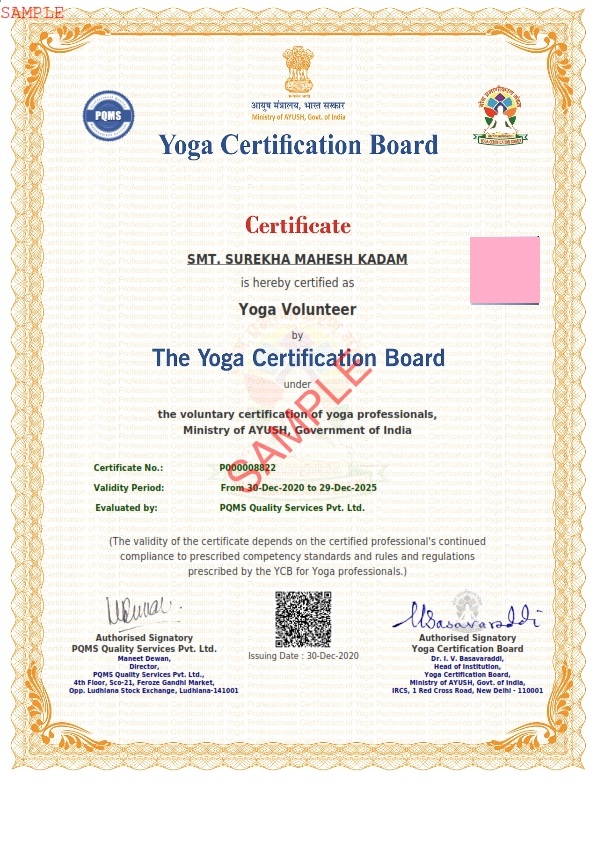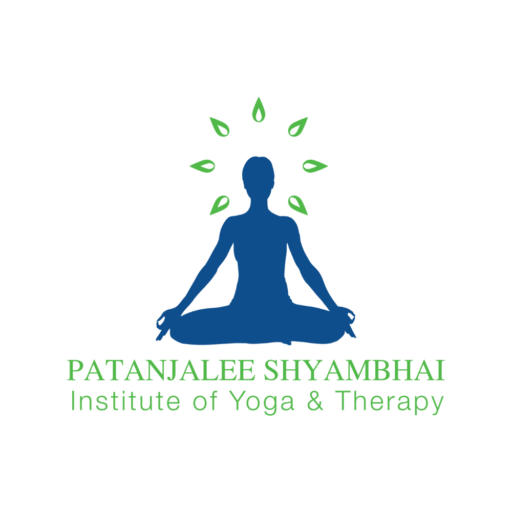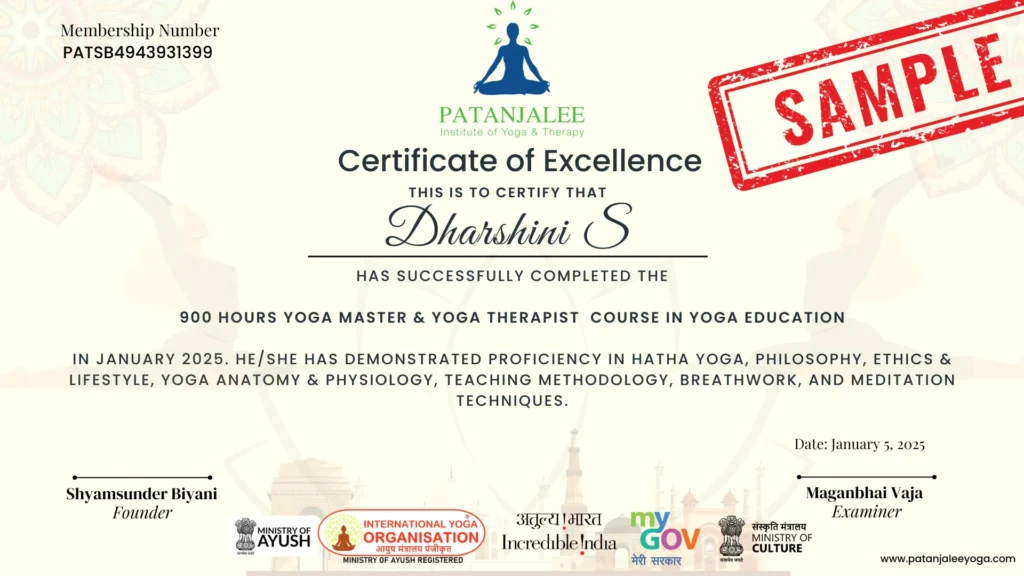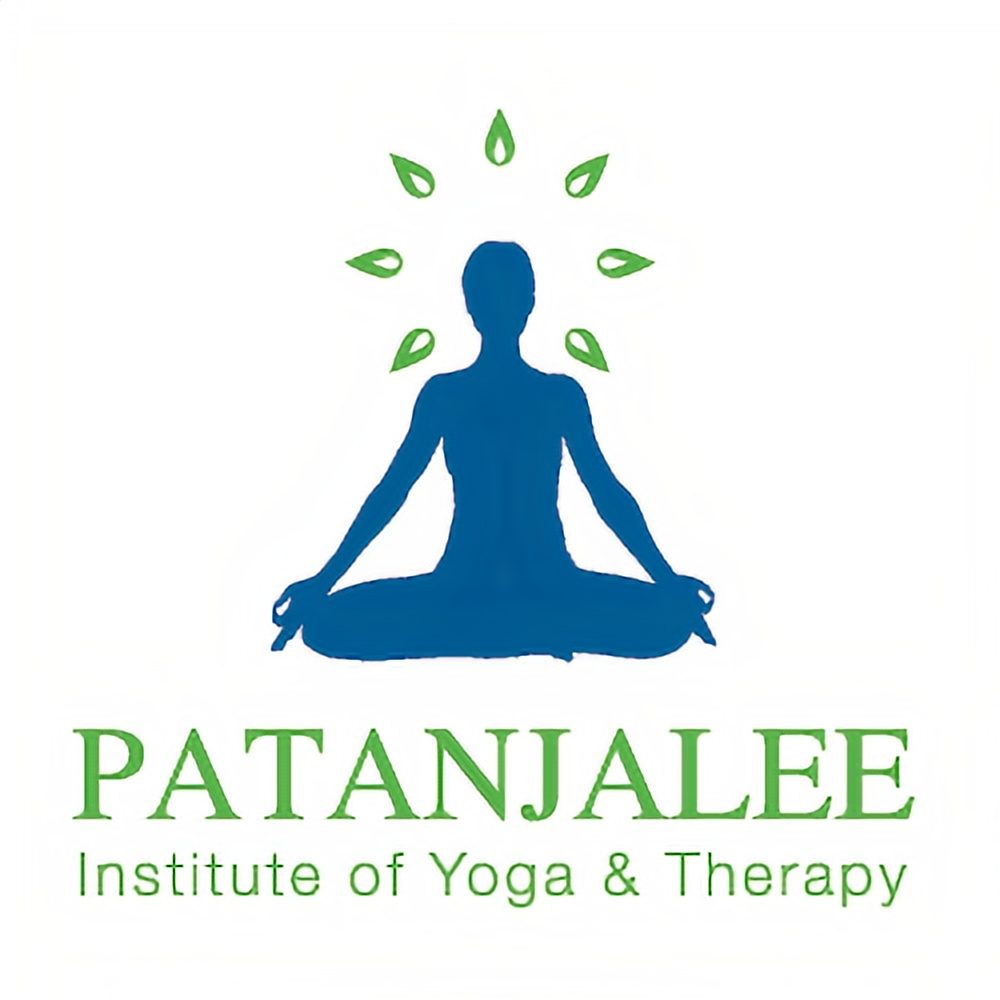
🧘♂️ 900 Hour Yoga Teacher Training Online!
🌟 Become YCB Certified Yoga Teacher
Yoga Certification Board


Patanjalee Shyambhai Yoga offers a 900-Hour Online Yoga Teacher Training Course that is YCB Certified. Our goal is to empower passionate and qualified yoga practitioners, enabling them to extend the healing benefits of yoga therapy to the general public.
By participating in our program, you will receive in-depth training and guidance from experienced instructors. This will equip you with the necessary skills and knowledge to serve others effectively.
Upon successful completion of the course, you will be awarded a YCB Certification, which recognizes your expertise and dedication. Our mission is to create a community of skilled yoga instructors who are not only well-versed in the traditional teachings of yoga, but also capable of adapting these teachings to the modern world. This allows us to make yoga accessible and beneficial for all.
Are you ready to transform and inspire? Join us and get certified to make a real difference in people’s lives. Let your passion for yoga ignite and heal, creating a positive impact on individuals and communities. Embrace the profound teachings of yoga and share its transformative power with the world.

🧘♂️ 900 Hour Yoga Teacher Training Online!
🌟 Become YCB Certified Yoga Teacher

Why Should You Join Our 900 hours Online Yoga Teacher Training?
🎓 YCB Certification Achieve internationally recognized certification through our accredited course.
🧘 Deep Understanding of Yoga Deepen your knowledge of yoga’s core practices and philosophy under the guidance of experienced, passionate instructors.
🚀 Kickstart Your Career Join a supportive community and gain opportunities to teach, collaborate, and build your brand as a yoga professional.
Online Yoga Teacher Training Details
Eligibility & Entry Requirements
To enroll in Level 3 (900 Hours Online Yoga Teacher Training) _ you must have a graduate degree and hold a Level 2 (500 Hours Online Yoga Teacher Training) certification.

1.1 Etymology and Definitions of Yoga (Patanjala Yoga Sutra, Bhagwad Gita, Kathopanishad)
1.2 Brief Introduction to origin, history and development of Yoga (Pre-Vedic period to contemporary times)
1.3 Yoga in Principle Upanishads
1.4 Yoga tradition in Jainism: Syadvada (theory of seven fold predictions); Concept of Kayotsarga/Preksha meditation)
1.5 Yoga Tradition in Buddhism: concept of Aryasatyas (four noble truths)
1.6 Salient features and branches of Bharatiya Darshana (Astika and Nastika Darshana)
1.7 General introduction to Shad Darshana with special emphasis on Samkhya, Yoga and Vedanta Darshana
1.8 Brief survey of Yoga in Modern and Contemporary Times (Shri Ramakrishna, Shri Aurobindo, Maharishi Raman, Swami Vivekananda, Swami Dayananda Saraswati, Swami Shivananda, Paramhansa Madhavadas ji, Yogacharya Shri T. Krishnamacharya)
1.9 Guiding principles to be followed by the practioner
1.10 Brief Introduction to Schools of Yoga; Jnana, Bhakti, Karma, Raja & Hatha
1.11 Principles and Practices of Jnana Yoga
1.12 Principles and Practices of Bhakti Yoga
1.13 Principles and Practices of Karma Yoga
1.14 Concept and Principles of Sukshma Vyayama, Sthula Vyayama, Surya Namaskars and their significance in Yoga Sadhana
1.15 Concept and Principles of Shatkarma: Meaning, Types, Principles and their significance in Yoga Sadhana
1.16 Concept and Principles of Yogasana: Meaning, definition, types and their significance in Yoga Sadhana
1.17 Concept and Principles of Pranayama: Meaning, definition, types and their significance in Yoga Sadhana
1.18 Introduction to Bandha & Mudra and their health benefits
1.19 Introduction to Yogic relaxation techniques with special reference to Yoga Nidra
1.20 Introduction to Dhyana and its role in health and well being
2.1 Introduction to Prasthanatrayee, Purushartha Chatushtaya and goal of human life
2.2 Yoga in Kathopanishad, Prashanopanishad, Taittiriyopnishad with special emphasis on Panchakosha Vivek and Ananda Mimamsa
2.3 Concept of Sthitaprajna (stages and characteristics) in Bhagavad Gita
2.4 Significance of Bhagavad Gita as a synthesis of Yoga
2.5 Concept of healthy living in Bhagavad Gita (Ahara, Vihara, Achara, Vichara)
2.6 Introduction and highlights of Yoga Vasishtha, Definitions of Yoga and their relevance in Yoga Vasishtha
2.7 Study of Patanjal Yoga Sutra including selected sutras from following chapters (I- 1 to 12, II 1 to 2, 46 to 55, III- 1 to 6)
2.8 Concept of Chitta, Chitta Bhumi, Chitta Vritti, Chitta Vikshepa, Chittaprasadanam, Klesha and Vivek-Khyati and their relationship with wellness
2.9 Concept of Ishwara and its relevance in Yogasadhana, qualities of Ishwara, Ishwarapranidhana
2.10 Concept of Kriya Yoga of Patanjali and its importance for healthy living
2.11 Bahiranga Yoga of Maharisi Patanjali (Yama, Niyama, Asana, Pranayama, Pratyahara)
2.12 Antaranga Yoga of Maharishi Patanjali (Dharana, Dhyana, Samadhi)
2.13 Concept of mental well-being according to Patanjala Yoga
2.14 Hatha Yoga: Its origin, history and development. Hatha Yoga: its meaning, and definition, aim, objectives and misconception about Hatha Yoga
2.15 Sadhaka Tattva and Badhaka Tattva principles to be followed by Hatha Yoga practitioner
2.16 Concept of Matha, Mitahara, Pathya & Apthaya, Types of Aspirants
2.17 Hatha Yoga practices according to different Hatha Yogic Texts (Hatha Pradipika, Gheranda Samhita and Hatharatnavali)
2.18 Concept of Shwasa-Prashwasa, Vayu, Prana, Upa-Prana, Shat Chakra etc.
2.19 Knowledge of Hatha Yoga practices for wellness (Shatkarma, Asanas, Pranayama, Mudra, Nadaanusandhana)
2.20 Relevance and importance of Hatha Yoga practices in health and well being
A. Introduction to Human Body – Anatomy and Physiology
3.1 Introduction to Human body
3.2 Basic structure and functions of Musculoskeletal system, Respiratory system, Cardio vascular system, Nervous system, Digestive system and Endocrine system
3.3 Homeostasis: its mechanism to maintain internal environment of the body
3.4 Introduction to sensory organs (Eyes, Nose, Ears, Tongue and Skin)
3.5 Impact of Yogic practices on different systems of the human body: Benefits of Shatkarma, Yogasana, Pranayama and Bandha on Respiratory, Circulatory, Musculoskeletal system
B. Introduction to Psychology
3.6 Introduction to psychology, concept of human psyche, stages of consciousness, cognitive process: Its meaning and nature
3.7 Definition and nature of Behavior, kinds of Behavior Motivation
3.8 Emotions: definition, nature and physiological changes during Emotion
3.9 Mental Health: Yogic view of Mental Health and Mental Illness
3.10 Role of Yoga in Mental Health. Importance of psychosocial environment for health and wellness
C. Yoga For Health And Wellness
3.11 Yogic concept of health, wellness and illness
3.12 Importance of psycho-social environment for health and wellness
3.13 Role of Yoga in various dimensions (physical, mental, social and spiritual) of health
3.14 Importance of following Dinacharya and Ritucharya for well being
3.15 Role of Ahara, Nidra and Brahmacharya in wellness
D. Yoga For Disease Prevention And Health Promotion
3.16 Meaning and definition of Health and Disease, Concept of Adhi and Vyadhi, Yoga as a preventive Health care- Heyam dukham anagatam
3.17 Potential causes of ill-health: Tapatrayas and Kleshas, Mental and Emotional ill Health: Anatrayas
3.18 Shuddhi Prakriyas in Yoga and their role in preventive and curative Health
3.19 Knowledge of Trigunas, Pancha-Kosha, Pancha-Prana and Shatkchakra and their role in Health and Disease
3.20 Yogic concept of Holistic Health and its importance in the management of Diseases
A. Yoga And Education
4.1 Education: Its meaning, definition and goal, role and importance of education in Human Excellence
4.2 Yoga in Education: Salient features of Yoga Education, Factors of Yoga Education: Teacher, Student and Teaching, Guru-Shishya-Parampara and its importance in Yoga Education
4.3 Value Education: Its Meaning and Definition, Types of values, value-oriented Education in Personality Development
4.4 Contribution of Yoga towards Development of Values, Spiritual Growth
4.5 Salient features of Ideal Yoga Teacher, Role of Yoga Teacher in Value-oriented Education, Role of Yoga in development of healthy society
B. Yoga For Personality Development
4.6 Personality: Meaning and types of personality
4.7 Determinants of Personality with reference to psycho-social environment
4.8 Knowledge of various facets and stages of development of personality
4.9 Personality Development; Role of spirituality and positive attitude in personality development
4.10 Role of Yogic practices (Asana, Pranayama, Shatkarma, Bandha, Mudra etc.) in the Personality Development
C. Yogic management of stress and its Consequences
4.11 Definition, nature and types of stress
4.12 Symptoms and consequences of stress on human mind
4.13 Yogic perspective of stress. Yogic principles for the management of stress and its consequences
4.14 Concepts and techniques of Stress management in Ashtanga Yoga of Patanjala Yogasutra and Bhagawad Gita
4.15 Specific practices for stress management: Yogasana, Breath Awareness, Shavasana, Yoganidra, Pranayama and Meditation
D. Yoga for prevention and management of Life Style Disorders
4.16 Concept of Yogic life style and its relevance
4.17 General knowledge about life style related disorders: Acidity, Constipation, Irritable bowel syndrome(IBS), Bronchial Asthma, Sinusitis, Hypertension, Neck pain, Low Backache, Osteo-arthritis etc.
4.18 Role of Yoga in prevention and management of common disorder: Acidity, Constipation, Irritable bowel syndrome (IBS), Bronchial Asthma, Sinusitis, Hypertension, Neck pain, Low Backache, Osteo-arthritis
4.19 Role of Yoga in prevention and management of non-communicable disorders
4.20 Yoga as an integrative medication
5.1 Prayer
– Concept and Recitation of Pranava
– Concept and Recitation of Hymns
– Selected universal prayers, invocations and Nishpatti Bhava
5.2 Yogic Shat Karma
– Neti: Sutra Neti and Jala Neti
– Dhauti: Vamana Dhauti (Kunjal)
– Kapalbhati (Vatakrama)
5.3 Yogic Sukshma Vyayama and Sthula Vyayama
Yogic Sukshma Vyayama (Microcirculation Practices)
– Neck Movement
– Griva Shakti Vikasaka (I,II,III,IV)
– Shoulder Movement
– Bhuja Valli Shakti Vikasaka
– Purna Bhuja Shakti Vikasaka
– Trunk Movement
– Kati Shakti Vikasaka (I, II, III, IV, V)
– Knee Movement
– Jangha Shakti Vikasaka (II-A&B)
– Janu Shakti Vikasaka
– Ankle movement
– Pada-mula shakti Vikasaka – A&B
– Gulpha-pada-pristha-pada-tala shakti Vikasaka
Yogic Sthula Vyayama (Macrocirculation Practices)
– Sarvanga Pushti
– Hrid Gati (Engine run)
5.4 Yogic Surya Namaskara with Mantra
5.5 Yogasana
– Tadasana, Hastottanasana, Vrikshasana
– Ardha Chakrasana, Padahastasana
– Trikonasana, Parshva Konasana, Katichakrasana
– Dandasana, Bhadrasana, Padmasana, Vajarasana
– Yogamudrasana, Parvatasana
– Mandukasana, Ushtrasana, Shashankasana, Utthana Mandukasana
– Paschimottanasana, Purvottanasana
– Vakrasana, Ardha Matsyendrasana, Gomukhasana
– Makarasana, Bhujangasana, Salabhasana, Dhanurasana
– Pavanamuktasana and its variations
– Uttanapadasana, Ardha Halasana, Setubandhasana, Saral-matsyasana
– Halasana, Chakrasana
– Sirshasana
– Shavasana
5.6 Preparatory Breathing Practices
– Sectional Breathing (Abdominal, Thoracic and Clavicular Breathing)
– Yogic Deep Breathing
– Anuloma Viloma/Nadi Shodhana
5.7 Pranayama
– Concept of Puraka, Rechaka and Kumbhaka
– Ujjayee Pranayama (Without Kumbhaka)
– Sheetali Pranayama (Without Kumbhaka)
– Sitkari Pranayama (Without Kumbhaka)
– Bhramari Pranayama (Without Kumbhaka)
5.8 Concept and Demonstration of Bandha and Mudra
– Jalandhara Bandha
– Uddiyana Bandha
– Mula Bandha
– Yoga Mudra
– Maha Mudra
– Vipareetakarani Mudra
5.9 Practices leading to Dhyana Sadhana
– Body awareness and Breath awareness
– Yoga Nidra
– Antarmauna
– Recitation of Pranava and Sohama
– Recitation of Hymns
– Practice of Dhyana
5.10 Methods of Teaching & Evaluation
– Teaching methods with special reference to Yoga
– Factors influencing Yoga teaching
– Need of teaching practice and its use in Yogic practice
– Teaching Aids: Meaning and Need, Role of Language, Voice, Fluency, Clarity and Body language in an ideal presentation
– Methods of teaching Yoga to an individual, small group and large group
– Use of audio-visual aids, ICT, multimedia and online resources
– Lecture cum demonstration in Yoga: Its meaning, importance and method of its Presentation
– Lesson plan: Its meaning and need
– Preparation of lesson plan in Yoga, Preparation of lesson plan for an individual and for a group
– Presentation of lessons in specific Yogic practices: Kriya, Asana, Pranayama, and Dhyana
– Assessment of a Yoga class (detection and correction of mistakes)
– Measurement, assessment and evaluation: concepts, principles and applications
– Examination reforms and designing formative and summative evaluation
– Programme evaluation: Yoga class/workshops/camps, yoga teaching, and yoga teacher
– Assessment of yoga centres and institutes- criteria, processes, instruments, results

To earn your yoga teacher certification through our program, you’ll need to meet the following requirements:
Ethical Conduct:
Commitment to Ashtanga Yoga:
Comprehensive Exam:
Adherence to Policies:
Attendance Requirement:

Our 900-hour course offers advanced training in yoga, Ayurveda, and meditation, achieving YCB certification and mastery for seasoned practitioners and dedicated teachers alike.
Our 500-hour program enhances your teaching with advanced asanas, therapeutic techniques, and deep yogic philosophy, leading to YCB certification and refined mastery.
Our Kids Yoga Teacher Training blends playful yoga poses, mindfulness, and teaching techniques, equipping you to inspire young minds, foster wellness, and achieve YCB certification.
Patanjalee Shyambhai Inst of Yoga & Therapy
A1003, Sanghvi S3 Eco City,
Mahajan Wadi,
Mira Road East Thane - 401107
shyamsunderbiyani24@gmail.com
+91 892 812 6174
+91 961 940 9657
Monday/Friday: 5am to 7pm
Saturday: 9am to 5.30pm
Sunday: Holiday or with prior appointments
